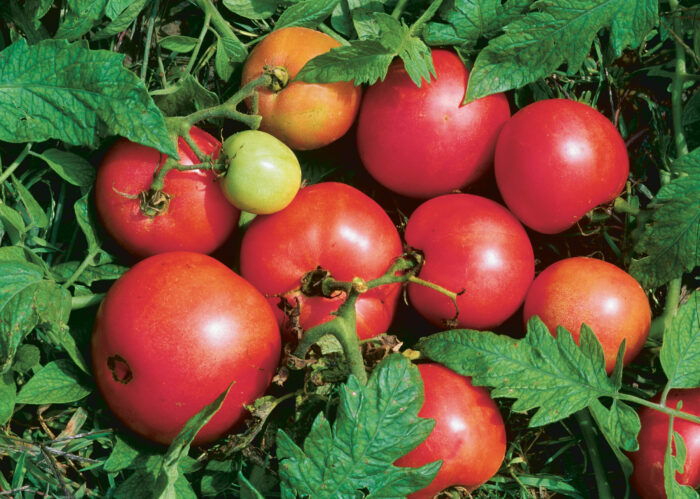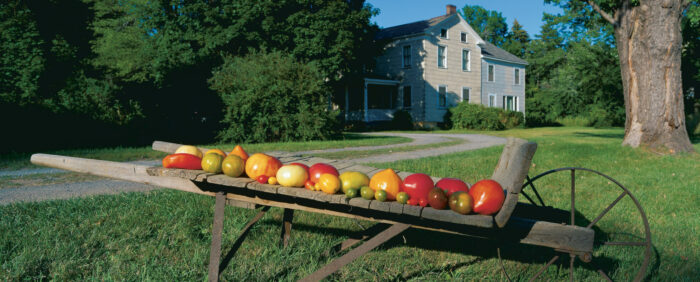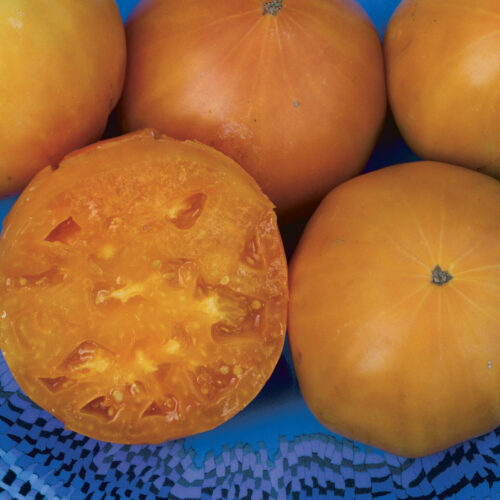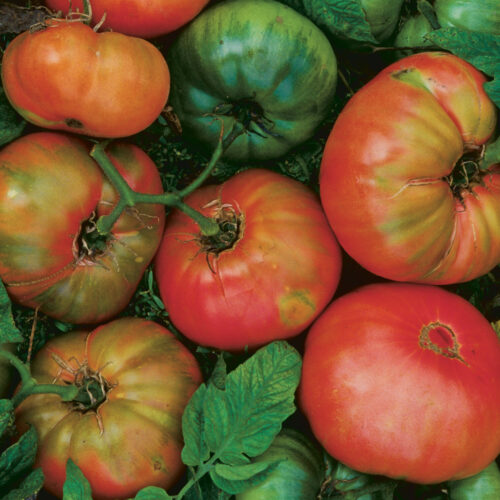Get to Know Heirloom Tomatoes
Varieties with a long history are better tasting than many hybrids

Word of mouth is always a great advertisement. I first ventured into heirloom tomatoes after hearing for the umpteenth time how swell ‘Brandywine’ was. If gardeners from New Jersey to California were extolling its virtues, it must be worth growing. And it was. Since that first ‘Brandywine’, I’ve grown ‘Persimmon’, ‘Old Flame’, ‘Georgia Streak’, and ‘German’, among others. And while I’d rather fight than give up my favorite hybrids, heirlooms now make up the lion’s share of my tomato crop.
Most of us cut our gardener’s teeth on hybrid tomatoes, those with names like ‘Jet Star’ or ‘Better Boy’ or ‘Ultra Girl’. With few exceptions, our chosen varieties were red, round, and—for the most part—the bigger, the better. There’s always been another side to the tomato world, though, a side where the fruits of the vine can be fluted, scalloped, flattened, lobed, or shaped like hearts or strawberries. When ripe they might be white, pink, red, orange, yellow, gold, purple, chocolate-brown, blackish-red, green, or striped. In addition to the typical tomato foliage, there are potato-leaf types, wispy fernlike leaves, and puckered rugose leaves. And the flavors range from sweet to tart, mild to strong, perfumed and fruity to dark and smoky.

To learn how to prune tomatoes, watch this video or read this article.
Part of an heirloom’s charm is its history, which is often as colorful as its skin. What homeowner can resist ‘Radiator Charlie’s Mortgage Lifter’? This gigantic tomato was developed in the 1930s by Charlie Byles, who kept a radiator repair shop in West Virginia. Byles repeatedly crossed four of the biggest tomatoes he could find. When he had a stable variety, he sold transplants for a dollar apiece and in six years paid off his mortgage. Or take ‘Cherokee Purple’, which dates to before 1890. About 10 years ago, Craig LeHoullier, a North Carolina chemist, got a letter and some tomato seeds from a stranger, J. D. Greene of Sevierville, Tennessee. This “purple” tomato had been in a neighbor’s family for years. Greene knew of LeHoullier’s interest in heirlooms and thought these seeds worth trying. Most so-called purple tomatoes are actually pink, so LeHouillier was delighted to discover this one was truly purple, and delicious at that.
If you like choices, you’ll love heirloom tomatoes
 |
 |
Ask anybody who pledges allegiance to heirloom tomatoes the question “Why?” and chances are you’ll get the same response: flavor. Heirlooms generally have more flavor than hybrids. And when you find the ones you really love, you’ll be able to taste them in your dreams.
Darrell Merrell of Tulsa, Oklahoma, got into heirlooms when he was looking for tomatoes that tasted like the ones his parents grew. He describes ‘Brandywine’ as having the old-time taste he was seeking, a perfect blend of sweet and acid. He describes the first time he tasted ‘Cherokee Purple’: “The flavors just exploded in my mouth. I held it up and did a 360 jig right there in the row.” Merrell gave up on hybrids three years ago. “Why waste time on them when there are so many interesting heirlooms to grow?”
 |
 |
It isn’t nostalgia that makes heirlooms taste better. It’s chemistry. Most are indeterminate, meaning they keep putting on new growth until they die. The more foliage a plant has in relation to fruit, the better the flavor, because leaves manufacture the sugars and acids that end up in the fruit. An abundance of leaves means an abundance of sugars and acids.So many varieties, so little room. There are 3,000 open-pollinated tomato varieties listed in the Seed Savers Exchange yearbook. According to founder Kent Whealy, only a quarter of those are true heirlooms, but that still leaves us 750 to choose from. So with space for only a handful, how do you pick a winner?

Probably the best way to find tomatoes worth growing is to taste them first. Sampling a recently picked, locally grown tomato will give you the best insight into whether that variety should be on your seed list. Thanks to heirlooms’ popularity, it’s getting easier to find opportunities to do this. At farmers’ markets, vendors often offer samplings, and organized tomato tastings are becoming standard end-of-summer events.
Just because a tomato has been around longer than you have doesn’t guarantee it’s going to taste great. There are duds among heirlooms, and part of that may be due to location. Heirlooms, after all, are regional, even local, varieties. A tomato cultivated for generations in Eastern Pennsylvania isn’t necessarily going to do well or taste great along the Texas coast.
If you haven’t tasted a lot of heirlooms yet, ask around. I’ve met some lovely tomatoes based on recommendations. But don’t believe everything you hear or read. ‘Costoluto Genovese’, which I bought based on catalog copy, is one heirloom whose charms totally elude me. In my garden, this variety’s squat, convoluted red fruits were mealy and tasteless. One fellow ‘Costoluto’ grower suggested the fruits need to be harvested before they become fully ripe, but I didn’t find it helped much.
Heirloom tomatoes have characteristics some people might consider disadvantages. The fruits are generally thinner skinned and softer than those of hybrids, so they’re more liable to crack or bruise. That makes sense, since heirlooms were selected for home gardens rather than for commercial production.

Also, the many indeterminate varieties need lots of staking and tying. The exuberant growth could overwhelm the unsuspecting gardener. Jeff Dawson, an heirloom grower in Sebastopol, California, prunes indeterminate tomatoes like a hedge, topping slicing varieties at 5 ft. and cherry types at 6 ft. This practice reduces weight and allows more sun in to ripen the season’s last fruits, but it’s also bound to sacrifice some flavor along with all those leaves.
Many heirlooms don’t yield as well as hybrids, but that’s partly why they have better flavor, since lower-yielding plants have more leaves per fruit. Certain large-fruited, potato-leaf varieties, like the legendary pink-fruited ‘Brandywine’, tend to have imperfect flowers, and so don’t self-pollinate as readily as other tomatoes. Gently flicking your fingers on the flowers should get the pollen where it needs to be. Or try plucking a freshly opened blossom and dabbing it onto other flowers. On the other hand, some heirlooms are very productive. For home gardeners who are growing for eating fresh, yield probably isn’t a big issue. They’ll gladly sacrifice quantity for taste.
Whether heirlooms are more susceptible to disease is a topic of debate. Many heirloom devotees say no. But it’s a fact that most modern hybrids have bred-in disease resistance that heirlooms don’t have. To get it, hybridizers use tomato species that have particular genes with high levels of resistance. In my own garden, I haven’t seen a marked difference in plant health between hybrids and heirlooms, and most gardeners I know report similar experiences. There are heirlooms that have tolerances for certain diseases—‘Eva Purple Ball’, ‘Radiator Charlie’s Mortgage Lifter’, and ‘Druzba’ are a few.
What is the difference between an old tomato and an heirloom tomato?
In the broadest picture, tomatoes fall into two categories: hybrid and open-pollinated.
A hybrid results from crossing two distinct parents, and produces fruit that is different from either parent. Hybridizing tomatoes involves a tremendous amount of hand labor. Tomato flowers contain both male and female parts, and in fact, most of the time pollinate themselves as they open. The first step in creating a hybrid is to emasculate the flowers on the female parent by trimming away the male parts before pollen becomes viable. Then pollen from the male parent is administered. It’s tedious work, and although most of it is done overseas where land and labor are cheap, it’s still an expensive proposition, which partly accounts for the high cost of hybrid seed.
An open-pollinated tomato was a hybrid, too, to begin with, but has been genetically stabilized by someone patiently selecting desirable fruits and growing out generations of tomatoes, always looking for the same things. Stabilizing usually takes several years, sometimes more than a dozen. Once a variety is stabilized, it will come true to seed. That is, year to year the plants and their fruits will be the same, unless you allow your plants to accidentally cross. Thanks to tomatoes’ self-pollinating nature, the odds are against that.
Heirlooms are a subset in the open-pollinated category. Most experts agree heirlooms are open-pollinated varieties that have been in existence for at least 50 years. Some devotees have an even stricter definition: It has to have been handed down through a family or a community to qualify as an heirloom. To them, a tomato variety may be more than 100 years old, but if it was developed as a commercial variety, it’ll never be an heirloom.
Save your own seed and put your stamp on an heirloom tomato
 |
 |
The key to getting really great heirlooms adapted to your growing conditions is saving your own seed. Jeff Dawson says at least 30% of the heirlooms he’s grown have improved with acclimatization. If a variety still doesn’t wow him after three years, he gives up on it. At the very least, Dawson says, grow one generation of seed you’ve saved yourself.
Others agree. Doreen Howard, who gardens on the hot, sticky Texas Gulf Coast, sees multiple advantages with home-saved seed. One is more tolerance to early blight, the biggest disease problem in her area. Heavier and earlier fruit set is another plus.
In a small garden, where there may not be room to separate varieties by several feet, you can guarantee self-pollination by loosely tying squares of row cover material around a cluster of flowers. Small paper bags work well, too. Be sure to put the protection on before the flowers have fully developed and opened, and take it off once they’ve dropped. Carolyn Male, the doyenne of heirloom tomato experts, cautions against growing the trendy, tiny-fruited currant tomatoes if you plan to save seed because they cross-pollinate easily with other tomatoes.
By the time you’ve grown a few generations of tomatoes from saved seeds, part of your heirloom’s past will be your own.
Great heirloom tomatoes to try
‘Arkansas Traveler’ (pink fruit, terrific flavor; heat-, pest-, and disease-tolerant)
‘Aunt Ginny’s Purple’ (big fruit with old-timey taste)
‘Aunt Ruby’s German Green’ (beefsteak type with rich, earthy flavor)
‘Druzba’ (red Bulgarian tomato, a pleasant blend of sweet and tart)
‘Galinas’ (Siberian yellow cherry, early and extremely productive)
‘Marizol Gold’ (pretty, slightly ribbed, bicolor fruits)
‘Pruden’s Purple’ (similar to ‘Brandywine’ but ripens 10 to 15 days earlier)
‘Regina’s Yellow’ (beautiful, huge bicolor fruits with fabulous flavor)
Fine Gardening Recommended Products

A.M. Leonard Deluxe Soil Knife & Leather Sheath Combo
Fine Gardening receives a commission for items purchased through links on this site, including Amazon Associates and other affiliate advertising programs.

The New Organic Grower, 3rd Edition: A Master's Manual of Tools and Techniques for the Home and Market Gardener, 30th Anniversary Edition
Fine Gardening receives a commission for items purchased through links on this site, including Amazon Associates and other affiliate advertising programs.

Berry & Bird Rabbiting Spade, Trenching Shovel
Fine Gardening receives a commission for items purchased through links on this site, including Amazon Associates and other affiliate advertising programs.






Comments
Going to try growing tomatoes at home now
http://www.garden365.com/container-gardening/growing-tomatoes-in-pots/
TOMATO ALICANTE Tomato Alicante (Lycopersicon esculentum) (45 Seeds Approx) A reliable favourite producing heavy crops of sweet, medium sized tomatoes. Perfect for your summer salad.
Indoor Planting: Sow seeds 1.5cm deep in pots or trays of moist compost, be careful not to over-water. Store in a warm location at an approx. temperature of 15-20c (59-68). When the seedlings are approx. 6" high, transfer to larger pots. The plants can be moved to an unheated glasshouse in April or hardened off and planted out from June. Support the plants when needed. Limit each plant to 4-5 trusses and pinch out the sides hoots. Feed regularly with a tomato feed.
Sow Indoors: February , April.
Harvest: June , September.
for more information click on the given link http://www.dabmoo.com/
Log in or create an account to post a comment.
Sign up Log in